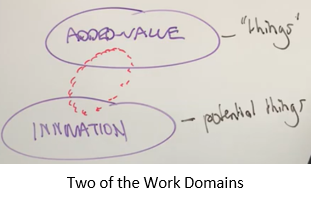Innovation – What It Really Is and What Makes It Work
You can watch this on video if you’d prefer to see me go through it rather than read.
Innovation. We all know it. There’s a fair chance it’s even one of your ‘values’.
What makes a huge difference to success in this area is understanding what we really are doing, and what we need to look at for it to work.
Luc Hoebeke’s Work Domains
My go-to person in this field is Luc Hoebeke – brilliant thinker and consultant from Belgium who wrote a wonderful book Making Work Systems Better, which he kindly made available on the internet (click the link).

Luc gives us a way to look at work using what he calls domains. It’s kind of hierarchical in that each later domain provides the conditions for the earlier domain to exist…but not hierarchical as you know it, because each domain is also it’s own complete system. They don’t ‘manage’ each other.
For our purposes here, we’ll stick with the first two domains (the other two are ‘values’ and ‘spiritual’), which are the ‘added-value’ domain and the ‘innovation’ domain. Picture them like this:

Each domain has it’s own ‘transformation process’. For the added-value domain it’s:
Transforming the needs of customer groups into actual products, services and processes….’things’.
So this is the world of work as we generally know it. Everything that’s made and provided…comes from this domain. And this includes the work of making various systems, departments, functions actually connect to each other. All part of the added-value domain.
The innovation domain is a different kettle of fish. Remember, it makes up it’s own complete system, and this one is
Transforming changes in the values of communities into potential ‘things’ for the added-value domain
Note how it’s still a transformation process and is therefore a work system…but with quite different inputs and outputs to the added-value domain.
Inventions are not Innovations
Now, here’s a key distinction. An innovation isn’t ‘in’ or ‘real’ until it’s embedded in the added-value domain. It’s available somehow. This means an invention and an innovation are not the same thing. And neither is an idea. Both inventions and ideas might by involved in innovation, but they are not sufficient on their own. The light bulb was not an innovation until it was a part of the added-value domain.
Added-Value Domain v Innovation Domain
Some distinctions can help us to tell the difference between the two domains.
Customers v Stakeholders – the added-value domain has customers who’s needs are met, the innovation domain creates potential customers we don’t know about yet…so can only have stakeholders
Augmenting/Improving v Discontinuity/Bifurcation – the added-value domain creates things that are ‘better’ for a known or understood group whereas the innovation domain will create a new situation for the added-value domain. It will be a stopping, or a point-of-no-return.
Better Networks v New Networks – the added-value domain improves and adds to existing networks – different suppliers, widening of the group whereas the innovation domain creates new networks that do not yet exist…a fundamental changing.

Your Innovation Strategy
The above distinction in no way discount the valuable work that’s probably going on in your organisation under the guise of ‘innovation’. New offerings, new product lines, bringing in methodologies all come under this heading. Looking for new ways to meet the wider needs of your customer base increases the value of the relationships for all involved…and providing what you do is ethical and doesn’t just add to the world of meaningless ‘stuff’…this is a good thing.
And…an ‘innovation’ strategy might well not be the smartest one for viability of your organisation. Unless you have, or can develop, particular capability in this area, it might be wiser if you just make sure you are ready to keep up with any innovations that look like changing things for real. Particularly if you are an established organisation with a customer base that values your existence.
(The taxi industry has been affected by Uber not because they didn’t think of the technology…but because they weren’t able to quickly match it as it became real. Investing collectively in discovering something like Uber would not have been good strategy…but awareness of, and ensuring the capability to create it could be quickly rounded up… would have been)
Four Factors of Innovation Success
When we are talking about genuine innovation in the Hoebeke sense, we need to know what we are looking for to create success. The world of standard measures – revenue, production, profit, ROI…these all belong to the added-value domain. They are the measures of the success of the relationship of value exchange…the transformation process of this domain.
The world of innovation is a different transformation process. This is where Hoebeke gives us his four factors to look at for a successful innovation which I have found to be highly effective. They are:
- Desirability
- Feasibility
- Transferability
- Systemicity
Weird words…but they will soon make sense.
Desirability
Desirability is at it sounds – how much positivity is put toward the innovation by those involved. The key is ‘those involved’ – we are talking about all stakeholders, which means those that will be affected by the change in some way. This is where predicted and/or actual quantitative numbers like revenue and ROI that apply in the added-value domain are useful…not as the answer…but as a way to influence desirability.
To put it simply – if no one wants it…it’s not going to happen.
Feasibility
Feasibility could be seen as the flip side of desirability. This time we are talking about the forces against the potential change. Hoebeke points out the famous Machiavelli quote here:
“…there is nothing more difficult to plan, more doubtful of success, nor more dangerous to manage than a new system. For the initiator has the enmity of all who would profit by the preservation of the old institution and merely lukewarm defenders in those who gain by the new ones.”
Machiavelli
It’s easy to shake your head and see this as a bad thing (which we only do when we are the ones who want things to be different), and forget that for a system to be viable…it can’t change with every new idea that comes down the line. Yet…a system must change as its environment does to remain viable.

This is quite topical right now in the world of human bodies…viruses must be battled for the body to remain viable, whereas changes brought on by exercise and good nutrition allow for ongoing flourishing in the environment.
In social systems, of which organisations are the one we experience the most, this tension of feasibility occurs through dialogue. The sharing of views, information, intuition and knowledge so decisions can ultimately lead to long-term viability.
Therefore it’s crucial that feasibility debates are welcomed and valued. ‘Resisting change’ is a key element of system viability…if there is dialogue.
To put it simply – if everyone hates it…it’s not going to happen.
Desirability and feasibility effectively lay the foundations for the other two factors.
Transferability
Onto one of the weird words now…transferability. This is the ability of the innovation to actually become a part of the added-value domain. Can it be got ‘in’? Hoebeke gives an example of bringing a technological innovation into farming communities that failed as the innovators assumed the men were the key-decision makers around changes to methods. Wrong. This poor choice of key stakeholders limited the ability of the innovation to transfer into the added-value domain.
Transferability also has a technical aspect. What platforms exist to let the innovation get a start? The changes brought on by Uber to the social structure of ride-sharing were readily transferable due to the ubiquity of mobile devices and familiarity of most in using apps and credit card payment.
Put simply – if we can’t get it in…it’s not going to happen
Systemicity
And the strangest word – systemicity. This is about seeing the innovation in its future context in the added-value domain, and looking at what other systems it would rely on for success…and what impact could it have.
A simple example Hoebeke provides is the electric car. What was an invention when he wrote the first edition of his book is now an innovation in the added-value domain as charging stations are now part of the landscape. Without these, electric cars could only be the realm of wealthy enthusiasts.
Knock-on effects are also an aspect of systemicity. We might ask about the impact the relentless pursuit of eyeballs undertaken by social media giants to gain added-value domain profits has on our social and mental wellbeing. For the viability of the wider networks of systems that impact quality of the community at large…consideration of the systemicity of innovations is a requirement.
Put simply – if what it needs to work can’t be provided…it’s not going to happen
What To Do
So how do we put this into action? Try these three actions.
Understand the Added-Value Domain
An innovation is not real until it’s embedded in the added-value domain. This requires those involved in innovation to have much more than passing familiarity with the current world of ‘things’. In other words, the aspects of transferability and systemicity need to be taken seriously, it’s not enough to put on a colourful hat, sparkly clothes and talk about ideas.

This does not mean that innovation must be continually connected to the added-value domain – a degree of separation is often helpful as the innovation domain is its own work system with its own outputs. It just must be done with awareness of what the possible endgame is, and this cannot be ignored or seen as an inconvenience.
Structure for Feasibility Dialogue
It’s in the debate between the current and the innovators that healthy decisions are made. This can be designed by ensuring that innovation project teams consist of or heavily involve those that currently work in the added-value domain. In Machiavelli’s words, those who would “profit by the preservation of the old institution”.
We are not bringing these people in to create ‘buy-in’ or other such trickery. What we are doing is genuinely getting this angle into the debate to ensure viability of the whole system. This in turn puts a big requirement on the ability of people to show up as adults and engage in actual debate. To be able to both listen as well as put views on the table, not with a need to ‘win’, but with a need to share and understand.
Seems simple…and it is…but this doesn’t mean it’s easy. It often needs some professional facilitation, at least at first. When I work in this area, concepts of adult ego development or ‘action logic‘ become crucial to help people understand where their own ‘meaning-making’ comes from…which in the end leads to a more viable organisation.
At the minimum, if you have some authority, or even if you don’t….make the discussions both intense…and not for sheep stations. Encourage angles. Let people know the goal is not always about consensus and movement…sometimes it’s just to ‘get what they are on about’.
Above All – Dialogue with Stakeholders
The key activity for successful innovation is dialogue. Remember, we do not have customers, we have stakeholders, and there are going to be winners and losers. Quantitative information turns from output to input, with judgment and intuition being at the centre as we look to give expression to change in societal values through innovations which become emdedded in the added-value domain.
The four factors of desirability, feasibility, transferability and systemicity ultimately come down to the ability to appreciate the angles of all and move things in directions that ultimately help the whole system. And appreciation comes from personal connection. Not aggregates of surveys and faceless masses, but from individual and group conversations with those that have, or will have, skin in the game.
It’s the sometimes icky work of real innovation…and it’s the key requirement for success. So, get out of email, out of your phone and start having some real conversations with no other agenda than to ‘get it’. And to let them get you.
Bringing it Home
There’s a bigger agenda here.
The added-value domain as it currently stands is simply not sustainable for the planet. We’re not making the right things, and we’re making too many things. The values change toward a global system that works for all is now underway, so it’s only through innovation that reflects this that we are all going to be OK in the long-run. And unless it get through to the added-value domain…it’s all just talk.
Getting good at this innovation show is what we all need. Now.
To paraphrase the words of a certain Princess: “help us Obi-Wan-Kenobi…you’re our only hope”
